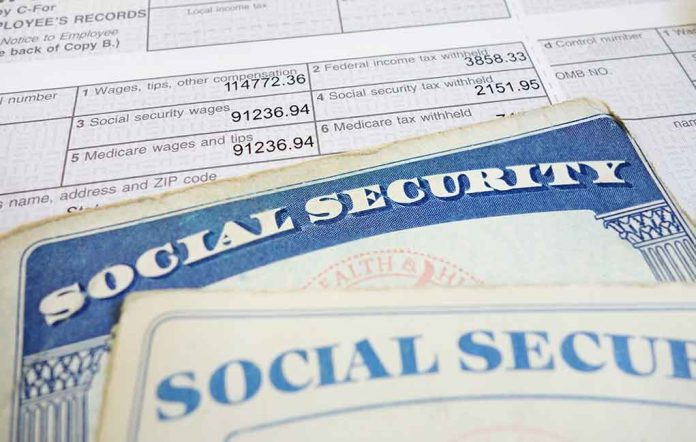🔴 Website 👉 https://u-s-news.com/
Telegram 👉 https://t.me/usnewscom_channel
Nearly 22 million American seniors are forced to survive on Social Security alone as their sole source of income, with 94% believing the upcoming 2025 cost-of-living adjustment will fail to match actual inflation rates.
Key Takeaways
- 21.8 million senior citizens in America are paying for all their expenses using only Social Security income, according to a new survey by The Senior Citizens League.
- 94% of seniors believe the announced 2.5% COLA increase for 2025 is insufficient to match the true inflation rates they experience in daily life.
- 75% of seniors rely on Social Security for at least half of their income, while it serves as nearly the entire income for 12% of men and 15% of women.
- 95% of seniors want Social Security and Medicare reform to be a top priority for President Trump’s administration.
- Seniors overwhelmingly support specific reforms, including eliminating the payroll tax income cap and changing how COLAs are calculated using the Consumer Price Index for the Elderly (CPI-E).
Social Security: From Supplement to Survival
Social Security was never designed to be a retiree’s sole source of income, yet for an alarming number of American seniors, it has become exactly that. As inflation continues to eat away at fixed incomes, the survey conducted by The Senior Citizens League reveals that 21.8 million seniors are completely dependent on their monthly Social Security checks for survival. The average retired worker receives approximately $1,975 monthly, an amount that must stretch to cover housing, food, healthcare, and all other necessities in an economy where prices continue to climb faster than benefits.
By the end of 2024, nearly 9 in 10 Americans aged 65 or older were collecting Social Security benefits. For 75% of seniors, these payments constitute at least half their income, highlighting how what was intended as a supplemental program has become the financial backbone for America’s elderly population. The growing dependence on these benefits reflects broader economic challenges, including diminished pension availability, inadequate retirement savings, and the devastating impacts of medical emergencies that can quickly deplete savings.
COLA Concerns: Measuring the Wrong Inflation
The annual Cost of Living Adjustment (COLA) announcement has become a moment of dread rather than relief for millions of seniors. The recently announced 2.5% increase for 2025 has been met with overwhelming skepticism, with 94% of surveyed seniors believing it will fail to match their actual experienced inflation. Four out of five seniors reported that their inflation rate in 2024 was higher than official government figures, creating a widening gap between their benefits and real expenses.
“If four in five seniors think inflation was higher than the government reported in 2024, maybe we should stop questioning their experiences and start questioning why the COLA is failing to measure them,” said TSCL Executive Director Shannon Benton.
The problem lies partly in how these adjustments are calculated. Currently, the Social Security Administration uses the Consumer Price Index for Urban Wage Earners and Clerical Workers (CPI-W), which doesn’t accurately reflect senior spending patterns. A striking 96% of seniors support reforming this calculation method, with many advocating for the Consumer Price Index for the Elderly (CPI-E), which would better account for the higher healthcare and housing costs that disproportionately impact older Americans.
Real Lives, Real Consequences
Behind these statistics are millions of individual stories of hardship. Lee Bliven, 74, and his wife, Susan, faced financial ruin after medical crises forced them into bankruptcy. “I didn’t have to worry about getting food on the table or paying a bill,” Bliven recalled of his pre-retirement life, highlighting the stark contrast to his current situation, where Social Security is their lifeline. Similarly, Dale Marshall, 66, who left her career to care for her mother with Alzheimer’s, now depends entirely on her benefits, stating, “I’ve been paying into the system since I was 16.”
“An estimated 21.8 million senior citizens in America make ends meet solely using their social security funds, The Senior Citizens League (TSCL) said in a June 20 statement,” reported The Epoch Times.
Carolyn Antell, 77, lost her business during the Great Recession and now survives on Social Security combined with subsidized housing. The Leedy sisters, Suzanne and Susan, aged 79 and 76 respectively, were forced into early retirement by medical issues. Suzanne points to a common reform proposal: “All they have to do is eliminate the cap,” referring to the income cap on Social Security payroll taxes that allows high-income earners to contribute proportionally less of their income to the system.
Reform Demands Growing Louder
As financial pressures mount, seniors are increasingly vocal about the need for meaningful reform. An overwhelming 95% of surveyed seniors want Social Security and Medicare reform to be a top priority for President Trump’s administration. Popular proposals include eliminating the payroll tax income cap to increase contributions from high-income earners, which would substantially improve the program’s finances. The current reconciliation bill offers some relief with a 4% tax deduction for Social Security recipients, but it falls short of the comprehensive reforms seniors are demanding.
“Seniors depend on these checks to survive. Any cuts would push millions further into poverty and undermine their right to a secure retirement,” warned Benton, emphasizing the critical importance of protecting and strengthening the program that millions of elderly Americans have come to rely upon completely.
With more than 68 million Social Security beneficiaries nationwide and growing concerns about the program’s long-term funding, the urgency for substantive action has never been greater. For the 21.8 million seniors whose entire financial existence depends on these monthly checks, the stakes couldn’t be higher – it’s quite literally a matter of survival.

